EV Batteries An Environmental Time Bomb
The green transition is pushing electric vehicles upon the American public as it is believed that they are less greenhouse gas intensive than gasoline vehicles. Electric vehicles, however, require lithium-ion batteries that have issues regarding greenhouse gas emissions during the mining and processing of the raw materials needed and the disposal of the batteries at the end of their life cycle. As more and more electric vehicles are sold, the problems inherent to mining and disposal increase. The graph below shows the huge increase expected in global EV battery demand. In the United States, electric vehicles are being forced on the public through proposed vehicle standards and purchase incentives in the Inflation Reduction Act, also known as the climate bill.

The production of lithium-ion batteries that power electric vehicles results in more carbon dioxide emissions than the production of gasoline-powered cars and their disposal at the end of their life cycle is a growing environmental concern as more and more electric vehicles populate the world’s roads. About 40 percent of the climate impact from the production of lithium-ion batteries comes from the mining and processing of the minerals needed. Mining and refining of battery materials, and manufacturing of the cells, modules and battery packs requires significant amounts of energy which generate greenhouse gases emissions. China, which dominates the world’s EV battery supply chain, gets almost 60 percent of its electricity from coal—a greenhouse gas-intensive fuel. According to the Wall Street Journal, lithium-ion battery mining and production are worse for the climate than the production of fossil fuel vehicle batteries. Production of the average lithium-ion battery uses three times more cumulative energy demand (CED) compared to a generic battery.

The disposal of the batteries is also a climate threat. If the battery ends up in a landfill, its cells can release toxins, including heavy metals that can leak into the soil and groundwater. A study from Australia found that 98.3 percent of lithium-ion batteries end up in landfills, which increases the likelihood of landfill fires that can burn for years. One landfill in the Pacific Northwest was reported to have had 124 fires between June 2017 and December 2020 due to lithium-ion batteries. Fires are becoming increasingly more common, with 21 fires reported on the site in 2018, increasing to 47 by 2020.
Recycling of lithium-ion batteries is being pushed by governments due to the environmental waste issues associated with them and the growing demand for batteries as more and more electric vehicles are sold. Only about 5 percent of the world’s lithium batteries are recycled compared to 99 percent of lead car batteries recycled in the United States. Recycling lithium batteries, however, can be hazardous. Cutting too deep into a cell or in the wrong place can result in it short-circuiting, combusting, and releasing toxic fumes. Because batteries differ widely in chemistry and construction, it is difficult to create efficient recycling systems. And because the cells are often held together with tough glues that make them difficult to take apart, it is often cheaper for battery makers to buy newly mined metals than to use recycled materials, even with rapidly increasing prices.
Governments are beginning to require some level of recycling, however. In 2018, China, which has the largest EV market and lithium-ion battery production, imposed rules aimed at promoting the reuse of EV battery components. Last year, the European Union passed rules for battery recycling that requires a certain percentage of recycled materials to be used in the manufacturing of new batteries.
Composition of Lithium Ion Batteries
A lithium-ion battery is composed of cells, which contain the active materials, a battery management system, and a pack, which is the structure in which the cells are mounted. Aluminum is important for the pack component because of its light weight but it is a very energy-intensive material, representing 17 percent of the battery’s carbon footprint. About 40 percent of the carbon footprint of the battery comes from the mining, conversion and refining step of the active materials of the cells where nickel, manganese, cobalt and lithium are processed into cathode powder. Actual cell production is the second most energy-demanding activity and represents 20 percent of the carbon footprint due to the energy used during the manufacturing process.
Issues with Mining of Battery Raw Materials
Two types of mining commonly required to extract minerals for batteries are open-pit mining and brine extraction. One of the major ways to extract lithium called brine extraction uses a large amount of water that is pumped into salt flats, bringing saltwater containing minerals to the surface. Once the water evaporates, lithium is filtered out of the mixture. But, the water-intensive process has the potential to contaminate the water supply. More than half the earth’s lithium supply is located in an area called the Lithium Triangle, spanning the Andean Mountain sections of Argentina, Bolivia and Chile. The area is one of the driest places on the globe, and lithium mining consumes as much as 65 percent of the region’s water. Any expansion of demand will place more pressure on water issues.
Also needed for electric vehicles is cobalt, the majority of which is mined in the Democratic Republic of Congo (DRC). The mining of cobalt produces hazardous byproducts that can toxify the environment. Cobalt mine sites often contain sulfur, which generate sulfuric acid when exposed to air and water that infiltrates rivers, streams and aquatic life. Child labor is also being used in the Congo to mine cobalt, and about 80 percent of the industrial cobalt mines in the DRC are owned or financed by Chinese companies.
Conclusion
Electric vehicle batteries require mining natural resources, processing them, and manufacturing the materials into batteries, which is energy intensive—3 times more energy intensive than the batteries in internal combustion vehicles. Further, when a battery is at the end of its life cycle, it is usually disposed of as e-waste in landfills that can result in hazardous compounds leaching into the soil and can cause large fires, which are extremely difficult to control due to the large amount of combustible waste that they are mixed with. Recycling the batteries is being pursued by governments, but it is expensive as there is no standardization in battery design and they are difficult to dismantle. Like many things related to the government-imposed green transition, it appears that much of the foresight that typically accompanies market-driven revolutions is actually hindsight, with consumers left to bear the brunt of unwise decisions and edicts.
*This article was adapted from content originally published by the Institute for Energy Research.

Speak Your Mind